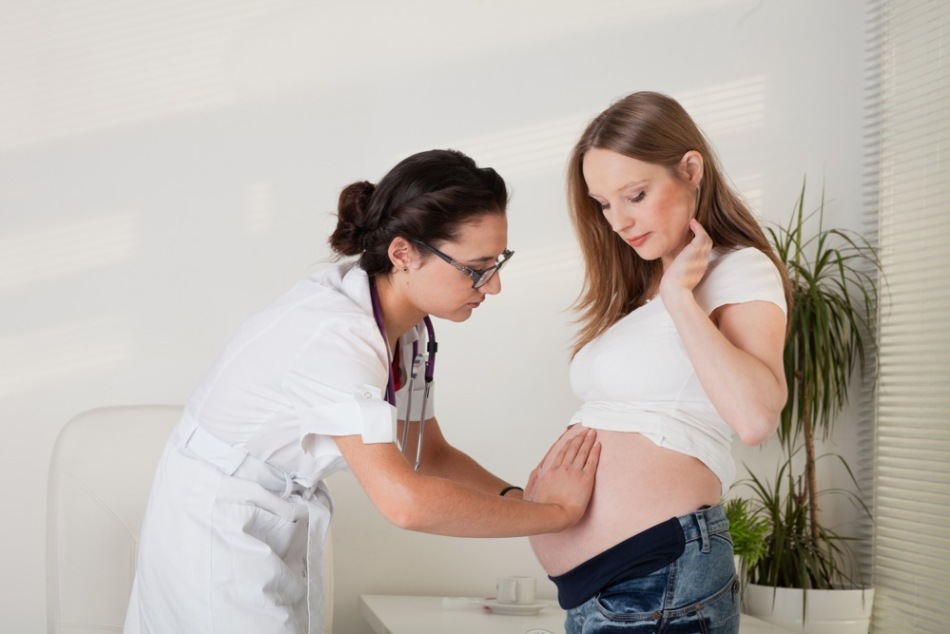The article says that low placentation during pregnancy means. Recommendations and advice to pregnant women with this pathology are given.
Content
- What does low placentation mean during pregnancy?
- Symptoms and causes of low placentation at any gestation period
- Low placentation at 20 weeks of pregnancy
- Low placentation at 21 weeks of pregnancy
- Low placentation at 22 weeks of pregnancy
- What is the danger of low placentation?
- Bandage with low placentation
- Can I have sex with low placentation?
- Low placentation treatment
- What to do with low placentation: tips and reviews
- Video: low placentation during pregnancy
At the twelfth week after fertilization in the female body, a special organ arises from a thickened inner shell, thanks to which two organisms are reported: maternal and childish.
This organ is the placenta. Through it, the mother body supplies nutrition, oxygen, vitamins for the child. The withdrawal of exchange products also occurs through the placenta
A reliable children's monastery consists of tightly adjacent to the wall of the uterus of the embryo shells. Having formed for a period of 16 weeks, the placenta is constantly growing, since the fetus is increasingly needed for nutrition, oxygen.
The laying of the placenta may be disrupted and violations. One of the likely pathologies is a low consolidation of children's place. 15% of women find such a problem
What does low placentation mean during pregnancy?
In order for the placenta to function normally, the embryo must gain a foothold in the upper part of the uterus. This is the optimal location: the bottom of the uterus is close to the embryo, where the formation of the placenta occurs. A children's place is justified where there are no scars, tumors, and myomatic nodes.
The low location of the children's place is the consolidation of the embryo from the lower part of the uterus near the pharynx. What is the danger to the fetus? The fact that the child is next to the blocked birth canal. Low placentation is diagnosed when fixing the lower edge of the children's place 6 cm from the uterine pharynx
 Symptoms and causes of low placentation at any gestation period
Symptoms and causes of low placentation at any gestation period
In pregnant women with a pathologically attached placenta, the following symptoms are observed:
- low pressure
- gestosis
- fruit hypoxia
If the fetus is not fixed very low, then these symptoms do not bother. Only a planned ultrasound shows the presence of pathology.
If the embryo is fixed too low, then women who resemble a spontaneous miscarriage are possible:
- pain in the lower abdomen, in the lower back
- excretion with blood from the birth canal
Doctors recommend that pregnant women not lose sight of the slightest changes taking place with them. A children's place can be refracted painlessly. The danger in this case is vaginal bleeding

Important: If the children's place is fixed low, then the fetus receives less oxygen. The receipt of the resources important for the full development of resources is reduced
Particularly imaginary and exciting patients doctors recommend maintaining calm and hope for a positive outcome of pregnancy. In the late stages in most pregnant women, the situation with the location of the placenta improves
 The uterus becomes larger, and the placenta “migrates”, in other words, occupies a normal position. If in the second trimester a woman learns about a low placentation, then it is likely that by the end of the third trimester of the placenta it will be higher without leaving the consequences for the fetus and mother.
The uterus becomes larger, and the placenta “migrates”, in other words, occupies a normal position. If in the second trimester a woman learns about a low placentation, then it is likely that by the end of the third trimester of the placenta it will be higher without leaving the consequences for the fetus and mother.
Only 10% of patients with a low fastening of the children's place abort the pregnancy after detecting pathology
A number of reasons can cause low placentation:
- various inflammations, infections, surgical interventions, abortions can provoke changes in the endometrium (inner layer of the uterus)
- complications during previous births
- uterine fibroids
- endometriosis
- inflammation of the cervix, its underdevelopment
- pregnancy by twins or triple
- late pregnancy
Pregnant women are more likely to learn about the low fastening of the children's place. In primitive placenta, the placenta is formed and fixed normally.
Low placentation at 20 weeks of pregnancy
Typically, planned ultrasound is prescribed for a period of 19-20 weeks. If a low attachment of the placenta is found during the examination, but the internal pharynx remains not blocked, the patient may hope for a successful outcome of pregnancy.
It is likely that the children's place will be higher than now. The placenta does not move freely inside the uterus, and with its growth rises a little
 Low placentation at 21 weeks of pregnancy
Low placentation at 21 weeks of pregnancy
The beginning of the second half of pregnancy, namely 21 weeks, accompany various changes. The kid already weighs four hundred grams with a height of 26 cm. A second ultrasound is prescribed to a pregnant woman. The purpose of this study is to identify violations in the child in the development of internal organs, as well as the brain.
A children's place performs a protective function simultaneously with the transfer of substances: microorganisms and toxins cannot penetrate through its walls to the fetus
Doctors warn their patients with a low placenta: you should be very attentive to discharge at 21 weeks of pregnancy.
- If a woman finds bloody discharge, then she should go to the doctor. Low attached placenta at this time can cause hospitalization
- 21 week for a patient with a low attached children's place is decisive: by this time the uterus usually becomes more in the amount so that the gap between the uterine is and the placenta also increases. Low attachment of children's places at this time disappears in 9 out of ten women
- The upcoming birth will pass without complications if the gap between the placenta and the uterine of the uterus will be 6 or more centimeters. Otherwise, doctors will have to pierce the fetal bladder and fix the placenta
- A patient with low placentation from 21 weeks requires special observation. Doctors with a high degree of professiaonalism should take childbirth from such a woman
- The input of the uterus can be completely closed, and the baby is located with the legs forward. The only way to avoid complications is the delivery at 38 weeks using cesarean section
Low placentation at 22 weeks of pregnancy
- At a period of 22 weeks, due to the growing child, the placenta may take a normal position. Then the child does not threaten the child and a woman can give birth without surgery
- However, it also happens that a children's place does not rise to this time, and the birth canal remain blocked for the natural process of childbirth. The situation is aggravated by the fact that the child occupies the position of the legs down
- The low fastening of the children's place at 22 weeks threatens the fetal hypoxia, which occurs due to insufficient intake of oxygen and nutrients. The child cannot fully develop. That is why at 22 weeks a children's place should be completely formed to provide the fetus with all the necessary

- At a period of 22 weeks with a diagnosis, a low placentation is under the constant supervision of doctors, since she may begin to detach the placenta, which leads to a miscarriage
- In order for childbirth without complications, you need to follow the instructions of doctors. Often women with low placentation are in a hospital, because the life of the child depends on the well -being of the future mother
- The reason for the incorrect formation of a children's place in a period of 22 weeks may be a dysfunctional environmental situation in the region and harmful working conditions
What is the danger of low placentation?
The danger of low consolidation of the placenta is that the disease can provoke the occurrence of unpleasant consequences for both the expectant mother and the fetus. The child is becoming more and more every day, and therefore the pressure on the lower part of the uterus increases
 A children's place, located too low, does not withstand the baby's weight and moves even more down. There is a risk of placental exfoliation. Vaginal bleeding may begin.
A children's place, located too low, does not withstand the baby's weight and moves even more down. There is a risk of placental exfoliation. Vaginal bleeding may begin.
The kid, who has “chosen” such an unsuccessful place for implantation, will develop with a lack of useful resources. This is due to less active blood circulation in the lower part of the uterus. But the worst consequence of a low -fixed children's place is a miscarriage.
Bandage with low placentation
Doctors advise patients with a low -fixed placenta not to forget to wear a bandage. It will help maintain stable pressure in the placenta during heavy loads. If you do not use a bandage, then a pregnant woman may begin to become severe bleeding
 Can I have sex with low placentation?
Can I have sex with low placentation?
For pregnant women with a low -attached placenta, sex is not a taboo if there are no other contraindications (no bleeding, detachment of fetal shells).
 However, the full -fledged sex life of a couple is possible subject to certain precautions:
However, the full -fledged sex life of a couple is possible subject to certain precautions:
- exclude strong and sharp shocks from sexual activity
- penetration should be soft and shallow
- it is better for a pregnant woman to lie on his side during intercourse
- be sure to comply with hygiene with both partners immediately before sex.
Low placentation treatment
Treatment with a low attached placenta is not carried out using medicines. Doctors watch the pregnant woman and expect when the children's place takes a suitable place. The forecast is more often positive. The position of the uterus will change over time, so do not perceive the diagnosis as a sentence.
Low placentation makes some changes to the usual regime familiar to the pregnant woman. You should adhere to the advice of doctors, constantly observe caution and keep well -being under control. Doctors recommend the following to their patients:
minimize physical activity- protect yourself from overwork, remain calm
- prevent sharp movements, do not raise your hands high up
- refuse for pregnancy from public transport
Remember: Any vaginal bleeding is an occasion to urgently consult a doctor. A woman should go through scheduled ultrasound in the deadlines specified by the doctor.
What to do with low placentation: tips and reviews
Natalia, 32 years old: “I have a second pregnancy and a placenta is low. Regarding sex, the doctor warned that my husband should be neat, but I would not strain. But I will not take risks, because we are talking about the life of our crumbs! "
Lyudmila, 34 years old: “When I heard the diagnosis of“ low placentation ”, she thought that everything was just terrible. But then she listened to the doctors, read the literature and calmed down. The situation is not fatal. We will have to limit yourself in motion more, constantly remember that any sharp movement can cause bleeding. But the prosperous birth of the baby with my diagnosis is not uncommon. I hope I will be among the happy mothers who have no complications during childbirth. "
Anastasia Andreevna, gynecologist: “At least a low mounting of a children's place and can disappear by itself, but a woman should minimize risks. To do this, she needs to monitor her well -being. If the slightest signs of malaise appear, it is better to go to the hospital immediately. Sometimes only hospitalization helps to normalize the condition of the pregnant woman. Physical peace should be accompanied by the peace of emotional "





 Low placentation at 21 weeks of pregnancy
Low placentation at 21 weeks of pregnancy Can I have sex with low placentation?
Can I have sex with low placentation?




